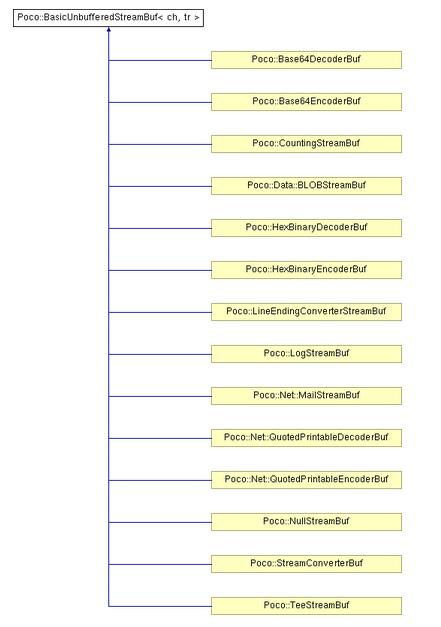POCO C++库学习和分析 -- 流 (二)
POCO C++库学习和分析 -- 流 (二)
2. 创建自己的流
2.1 自定义流的结构
在Poco中提供了一个框架用于创建自己的流,并且创建的流都符合C++标准。想一下标准库中流的层次和结构。每一个流都必须有对应的流缓冲,并且在流初始化时提供此流缓冲的指针。Poco中提供了3种流缓冲供选择,分别是BasicBufferedStreamBuf、BasicUnbufferedStreamBuf、BasicBufferedBidirectionalStreamBuf。首先来看一个例子:#include "Poco/UnbufferedStreamBuf.h"
#include <ostream>
#include <cctype>
class UpperStreamBuf: public UnbufferedStreamBuf
{
public:
UpperStreamBuf(std::ostream& ostr): _ostr(ostr)
{}
protected:
int writeToDevice(char c)
{
_ostr.put(toupper(c));
return charToInt(c);
}
private:
std::ostream& _ostr;
};
class UpperIOS: public virtual std::ios
{
public:
UpperIOS(std::ostream& ostr): _buf(ostr)
{
poco_ios_init(&_buf);
}
protected:
UpperStreamBuf _buf;
};
class UpperOutputStream: public UpperIOS, public std::ostream
{
public:
UpperOutputStream(std::ostream& ostr):
UpperIOS(ostr),
std::ostream(&_buf)
{}
};
int main(int argc, char** argv)
{
UpperOutputStream upper(std::cout);
upper << "Hello, world!" << std::endl;
return 0;
}从上面的例子中,我们看到用户自定流缓冲类型UpperStreamBuf,并自定义流类型UpperIOS和UpperOutputStream。其中UpperIOS从std::ios虚拟继承。注意这里是虚拟继承,这是为了保证UpperOutputStream多重继承时的菱形结构(std::ostream也是从std::ios虚拟继承的)。再回忆一下,std::ios的作用,其中最重要的就是定义了缓冲区指针。那么很自然的,定义UpperIOS,并让UpperOutputStream从UpperIOS继承的原因,就是为了让UpperOutputStream类拥有自己的缓冲区。再来看从流std::ostream继承的原因,很简单,为了继承"<<"操作符。那么清楚了,如果是输入流,从std::istream继承;是输入输出流从std::iostream继承。
再从上面的例子看:为什么说,Poco中流框架提供的是一个中介流的框架。当创建UpperOutputStream对象时,我们看它做了什么.
在调用UpperOutputStream upper(std::cout)时,传入参数是一个std::cout,这是一个已定义的流对象。这个流对象被赋予给UpperIOS类,用来初始化UpperIOS类中的UpperStreamBuf对象;而UpperStreamBuf又并不负责直接输出,它的输出依赖于内部的std::ostream对象,在这里就是std::cout。另一方面由于UpperOutputStream对象同时也继承自std::ostream,而std::ostream必须要求用一个流缓冲对象来初始化,所以在UpperIOS类中的UpperStreamBuf对象初始化后,又被赋给std::ostream对象用作初始化。
再来看 "upper << "Hello, world!" << std::endl "语句的执行过程:
1. "<<"操作符是std::ostream的成员函数。也就是说 "Hello, world!"被首先调用了std::ostream函数"<<"。
2. 我们知道,流的输入输出是委托给其内部的缓冲区对象的。也就是说,在这里"<<"操作符,会委托到std::ostream类内部关联的流缓冲UpperIOS::UpperStreamBuf对象_buf上。
2. UpperStreamBuf类型的_buf对象并不输出,它把输出任务继续委托给内部的流对象_ostr。在程序里,_ost对象为std::cout。
3. std::cout对象在收到数据后,委托给std::cout内部关联的流缓冲对象,最终输出。至于std::cout对象关联的流对象是什么,那就不用去管了。这是系统内部实现的。
转了半天,输出最终还是依赖于系统的默认输出。如果仅是如此,就没有意思了。Poco流在类BasicBufferedStreamBuf、BasicUnbufferedStreamBuf、BasicBufferedBidirectionalStreamBuf上开了一个小口,供用户自定义中间操作。这两个小口就是:
通过子类继承,用户可以自定义转换行为。任何从Poco流自定义框架出来的类都必须重新定义这两个虚函数。readFromDevice和writeToDevice会在std::ostream中的虚函数overflow和underflow中被调用。
在了解了Poco自定义流类的流转次序后,再去看Poco中的自定义流Base64Decoder,Base64Encoder等的数据流转,会发现过程都是类似的。下面就不再对这一方面进行叙述。只是讲一下Poco中已定义的3个流缓冲类BasicBufferedStreamBuf、BasicUnbufferedStreamBuf、BasicBufferedBidirectionalStreamBuf。
Poco::BasicUnbufferedStreamBuf可以说是最简单的创建用户自定流的方法,在其内部没有任何缓冲对象。从Poco::BasicUnbufferedStreamBuf继承的类需要重载readFromDevice和writeToDevice接口。
对应重载的要求如下:
在Poco中从UnbufferedStreamBuf继承的类见下图:

2. UpperStreamBuf类型的_buf对象并不输出,它把输出任务继续委托给内部的流对象_ostr。在程序里,_ost对象为std::cout。
3. std::cout对象在收到数据后,委托给std::cout内部关联的流缓冲对象,最终输出。至于std::cout对象关联的流对象是什么,那就不用去管了。这是系统内部实现的。
转了半天,输出最终还是依赖于系统的默认输出。如果仅是如此,就没有意思了。Poco流在类BasicBufferedStreamBuf、BasicUnbufferedStreamBuf、BasicBufferedBidirectionalStreamBuf上开了一个小口,供用户自定义中间操作。这两个小口就是:
virtual int readFromDevice(char_type* buffer, std::streamsize length); virtual int writeToDevice(const char_type* buffer, std::streamsize length);
通过子类继承,用户可以自定义转换行为。任何从Poco流自定义框架出来的类都必须重新定义这两个虚函数。readFromDevice和writeToDevice会在std::ostream中的虚函数overflow和underflow中被调用。
在了解了Poco自定义流类的流转次序后,再去看Poco中的自定义流Base64Decoder,Base64Encoder等的数据流转,会发现过程都是类似的。下面就不再对这一方面进行叙述。只是讲一下Poco中已定义的3个流缓冲类BasicBufferedStreamBuf、BasicUnbufferedStreamBuf、BasicBufferedBidirectionalStreamBuf。
2.2 BasicUnbufferedStreamBuf
Poco::BasicUnbufferedStreamBuf是一个使用char作为模板参数类型的偏特化模板类。其完整定义为:template <typename ch, typename tr>
class BasicUnbufferedStreamBuf: public std::basic_streambuf<ch, tr>
/// This is an implementation of an unbuffered streambuf
/// that greatly simplifies the implementation of
/// custom streambufs of various kinds.
/// Derived classes only have to override the methods
/// readFromDevice() or writeToDevice().
{
// .....
int_type _pb;
bool _ispb;
}
typedef BasicUnbufferedStreamBuf<char, std::char_traits<char> > UnbufferedStreamBuf;Poco::BasicUnbufferedStreamBuf可以说是最简单的创建用户自定流的方法,在其内部没有任何缓冲对象。从Poco::BasicUnbufferedStreamBuf继承的类需要重载readFromDevice和writeToDevice接口。
对应重载的要求如下:
int readFromDevice()读取并返回单字节无符号字符。如果没有更多的合适数据时,返回char_traits::eof()(-1)。需要注意的是,不要直接返回一个char类型值,因为char类型值是一个有符号数。调用int charToInt(char c)返回一个char转换到int的值。
int writeToDevice(char c)写入一个单字节字符,如果成功返回写入的字符(已整形方式),否则返回char_traits::eof() (-1).
在Poco中从UnbufferedStreamBuf继承的类见下图:
2.3 BasicBufferedStreamBuf
Poco::BasicBufferedStreamBuf也同样是使用char作为模板参数类型的偏特化模板类。其完整定义为:template <typename ch, typename tr, typename ba = BufferAllocator<ch> >
class BasicBufferedStreamBuf: public std::basic_streambuf<ch, tr>
/// This is an implementation of a buffered streambuf
/// that greatly simplifies the implementation of
/// custom streambufs of various kinds.
/// Derived classes only have to override the methods
/// readFromDevice() or writeToDevice().
///
/// This streambuf only supports unidirectional streams.
/// In other words, the BasicBufferedStreamBuf can be
/// used for the implementation of an istream or an
/// ostream, but not for an iostream.
{
// ...
std::streamsize _bufsize;
char_type* _pBuffer;
openmode _mode;
}
typedef BasicBufferedStreamBuf<char, std::char_traits<char> > BufferedStreamBuf;在BasicBufferedStreamBuf内部存在一个_pBuffer,用作缓冲,供输出使用。Poco::BufferedStreamBuf的实例支持读写,但不支持同时读写。从Poco::BasicBufferedStreamBuf继承的类需要重载readFromDevice和writeToDevice接口。
对应重载的要求如下:
int readFromDevice(char* buffer, std::streamsize length)读取指定长度的字符,并把它们放置在buffer中。返回读到的字节数,或者-1(当错误发生时)
int writeToDevice(const char* buffer, std::streamsize length)写入buffer中指定数目的字节。返回读到的字节数,或者-1(当错误发生时)
在Poco中从BasicBufferedStreamBuf继承的类见下图:
2.4 BasicBufferedBidirectionalStreamBuf
Poco::BasicBufferedBidirectionalStreamBuf一样是使用char作为模板参数类型的偏特化模板类。其完整定义为:template <typename ch, typename tr, typename ba = BufferAllocator<ch> >
class BasicBufferedBidirectionalStreamBuf: public std::basic_streambuf<ch, tr>
/// This is an implementation of a buffered bidirectional
/// streambuf that greatly simplifies the implementation of
/// custom streambufs of various kinds.
/// Derived classes only have to override the methods
/// readFromDevice() or writeToDevice().
///
/// In contrast to BasicBufferedStreambuf, this class supports
/// simultaneous read and write access, so in addition to
/// istream and ostream this streambuf can also be used
/// for implementing an iostream.
{
// ....
std::streamsize _bufsize;
char_type* _pReadBuffer;
char_type* _pWriteBuffer;
openmode _mode;
}
typedef BasicBufferedBidirectionalStreamBuf<char, std::char_traits<char> > BufferedBidirectionalStreamBuf;在BasicBufferedBidirectionalStreamBuf内部存在两个缓冲,_pReadBuffer和_pWriteBuffer,作为缓冲,分别供输入或输出使用。
Poco::BasicBufferedBidirectionalStreamBuf的实例支持同时读写。从Poco::BasicBufferedBidirectionalStreamBuf继承的类需要重载readFromDevice和writeToDevice接口。
对应重载的要求如下:
int readFromDevice(char* buffer, std::streamsize length)读取指定长度的字符,并把它们放置在buffer中。返回读到的字节数,或者-1(当错误发生时)
int writeToDevice(const char* buffer, std::streamsize length)写入buffer中指定数目的字节。返回读到的字节数,或者-1(当错误发生时)
在Poco中从BasicBufferedBidirectionalStreamBuf继承的类见下图:
3. Poco::Base64Encoder和Poco::Base64Decoder
3.1 Base64编码的概念
Base64是一种基于64个可打印字符来表示二进制数据的表示方法。由于2的6次方等于64,所以每6个位元为一个单元,对应某个可打印字符。三个字节有24个位元,对应于4个Base64单元,即3个字节需要用4个可打印字符来表示。它可用来作为电子邮件的传输编码。在Base64中的可打印字符包括字母A-Z、a-z、数字0-9 ,这样共有62个字符,此外两个可打印符号在不同的系统中而不同。
Base64常用于在通常处理文本数据的场合,表示、传输、存储一些二进制数据。包括MIME的email,email via MIME, 在XML中存储复杂数据.
Base64常用于在通常处理文本数据的场合,表示、传输、存储一些二进制数据。包括MIME的email,email via MIME, 在XML中存储复杂数据.
Base64索引表:
| Value | Char | Value | Char | Value | Char | Value | Char | |||
|---|---|---|---|---|---|---|---|---|---|---|
| 0 | A | 16 | Q | 32 | g | 48 | w | |||
| 1 | B | 17 | R | 33 | h | 49 | x | |||
| 2 | C | 18 | S | 34 | i | 50 | y | |||
| 3 | D | 19 | T | 35 | j | 51 | z | |||
| 4 | E | 20 | U | 36 | k | 52 | 0 | |||
| 5 | F | 21 | V | 37 | l | 53 | 1 | |||
| 6 | G | 22 | W | 38 | m | 54 | 2 | |||
| 7 | H | 23 | X | 39 | n | 55 | 3 | |||
| 8 | I | 24 | Y | 40 | o | 56 | 4 | |||
| 9 | J | 25 | Z | 41 | p | 57 | 5 | |||
| 10 | K | 26 | a | 42 | q | 58 | 6 | |||
| 11 | L | 27 | b | 43 | r | 59 | 7 | |||
| 12 | M | 28 | c | 44 | s | 60 | 8 | |||
| 13 | N | 29 | d | 45 | t | 61 | 9 | |||
| 14 | O | 30 | e | 46 | u | 62 | + | |||
| 15 | P | 31 | f | 47 | v | 63 | / |
Base64是一种基于64个可打印字符来表示二进制数据的表示方法。由于2的6次方等于64,所以每6个位元为一个单元,对应某个可打印字符。三个字节有24个位元,对应于4个Base64单元,即3个字节需要用4个可打印字符来表示。它可用来作为电子邮件的传输编码。在Base64中的可打印字符包括字母A-Z、a-z、数字0-9
,这样共有62个字符,此外两个可打印符号在不同的系统中而不同。
| 文本(1 Byte) | A | |||||||||||||||||||||||
|---|---|---|---|---|---|---|---|---|---|---|---|---|---|---|---|---|---|---|---|---|---|---|---|---|
| 二进制位 | 0 | 1 | 0 | 0 | 0 | 0 | 0 | 1 | ||||||||||||||||
| 二进制位(补0) | 0 | 1 | 0 | 0 | 0 | 0 | 0 | 1 | 0 | 0 | 0 | 0 | ||||||||||||
| Base64编码 | Q | Q | ||||||||||||||||||||||
| 文本(2 Byte) | B | C | ||||||||||||||||||||||
| 二进制位 | 0 | 1 | 0 | 0 | 0 | 0 | 1 | 0 | 0 | 1 | 0 | 0 | 0 | 0 | 1 | 1 | x | x | x | x | x | x | ||
| 二进制位(补0) | 0 | 1 | 0 | 0 | 0 | 0 | 1 | 0 | 0 | 1 | 0 | 0 | 0 | 0 | 1 | 1 | 0 | 0 | x | x | x | x | x | x |
| Base64编码 | Q | k | M | |||||||||||||||||||||
举例来说,一段引用自托马斯·霍布斯的利维坦的文句:
Man is distinguished, not only by his reason, but by this singular passion from other animals, which is a lust of the mind, that by a perseverance of delight in the continued and indefatigable generation of knowledge, exceeds the short vehemence of any carnal pleasure.
经过base64编码之后变成:
TWFuIGlzIGRpc3Rpbmd1aXNoZWQsIG5vdCBvbmx5IGJ5IGhpcyByZWFzb24sIGJ1dCBieSB0aGlz IHNpbmd1bGFyIHBhc3Npb24gZnJvbSBvdGhlciBhbmltYWxzLCB3aGljaCBpcyBhIGx1c3Qgb2Yg dGhlIG1pbmQsIHRoYXQgYnkgYSBwZXJzZXZlcmFuY2Ugb2YgZGVsaWdodCBpbiB0aGUgY29udGlu dWVkIGFuZCBpbmRlZmF0aWdhYmxlIGdlbmVyYXRpb24gb2Yga25vd2xlZGdlLCBleGNlZWRzIHRo ZSBzaG9ydCB2ZWhlbWVuY2Ugb2YgYW55IGNhcm5hbCBwbGVhc3VyZS4=
编码“Man”
| 文本 | M | a | n | |||||||||||||||||||||
|---|---|---|---|---|---|---|---|---|---|---|---|---|---|---|---|---|---|---|---|---|---|---|---|---|
| ASCII编码 | 77 | 97 | 110 | |||||||||||||||||||||
| 二进制位 | 0 | 1 | 0 | 0 | 1 | 1 | 0 | 1 | 0 | 1 | 1 | 0 | 0 | 0 | 0 | 1 | 0 | 1 | 1 | 0 | 1 | 1 | 1 | 0 |
| 索引 | 19 | 22 | 5 | 46 | ||||||||||||||||||||
| Base64编码 | T | W | F |
u |
||||||||||||||||||||
基本上说,如果那天你看到一段以“=”或者"=="结束的字符,你就可以判断这段字符用了Base64编码。就应用而言,我只在邮件内容发送和MD5 或者SHA密码保存时见过Base64编码。
实现上Base64算法很简单,把流变成二进制,然后按6位转换为字符保存。
3.2 Poco::Base64Encode
Poco::Base64Encode的类图如下:
3.3 Poco::Base64Decoder
Poco::Base64Decoder的类图如下:
3.4 例子
下面是一个例子
#include "Poco/Base64Encoder.h"
#include <iostream>
using Poco::Base64Encoder;
int main(int argc, char** argv)
{
Base64Encoder encoder(std::cout);
encoder << "Hello, world!";
return 0;
}4. Poco::HexBinaryEncoder和Poco::HexBinaryDecoder
4.1 HexBinary编码编码概念
HexBinary编码又叫Base 16编码,Base16是一种基于16个可打印字符来表示二进制数据的表示方法。由于2的4次方等于16,所以每4个位元为一个单元,对应某个可打印字符。三个字节有24个位元,对应于6个Base64单元,即3个字节需要用6个可打印字符来表示。
Base16索引表:
The Base 16 Alphabet
Value Encoding Value Encoding Value Encoding Value Encoding
0 0 4 4 8 8 12 C
1 1 5 5 9 9 13 D
2 2 6 6 10 A 14 E
3 3 7 7 11 B 15 F
还是以编码“Man”举例:
| 文本 | M | a | n | |||||||||||||||||||||
| ASCII编码 | 77 | 97 | 110 | |||||||||||||||||||||
| 二进制位 | 0 | 1 | 0 | 0 | 1 | 1 | 0 | 1 | 0 | 1 | 1 | 0 | 0 | 0 | 0 | 1 | 0 | 1 | 1 | 0 | 1 | 1 | 1 | 0 |
| 索引 | 4 | 13 | 6 | 1 | 6 | 14 | ||||||||||||||||||
| base 16编码 | 4 | D | 6 | 1 | 6 | E | ||||||||||||||||||
实现上Base16算法很简单,把流变成二进制,然后按4位转换为字符保存。
4.2 Poco::HexBinaryEncoder和Poco::HexBinaryDecoder
Poco::HexBinaryEncoder 和Poco::HexBinaryDecoder的类图同Poco::Base64Encoder和Poco::Base64Decoder是类似。
HexBinaryDecoderBuf定义如下:
class Foundation_API HexBinaryDecoderBuf: public UnbufferedStreamBuf
/// This streambuf decodes all hexBinary-encoded data read
/// from the istream connected to it.
/// In hexBinary encoding, each binary octet is encoded as a character tuple,
/// consisting of two hexadecimal digits ([0-9a-fA-F]) representing the octet code.
/// See also: XML Schema Part 2: Datatypes (http://www.w3.org/TR/xmlschema-2/),
/// section 3.2.15.
///
/// Note: For performance reasons, the characters
/// are read directly from the given istream's
/// underlying streambuf, so the state
/// of the istream will not reflect that of
/// its streambuf.
{
public:
HexBinaryDecoderBuf(std::istream& istr);
~HexBinaryDecoderBuf();
private:
int readFromDevice();
int readOne();
std::streambuf& _buf;
};
构造文件为:
HexBinaryDecoderBuf::HexBinaryDecoderBuf(std::istream& istr):
_buf(*istr.rdbuf())
{
}


